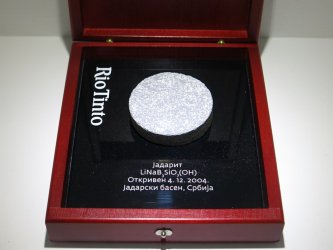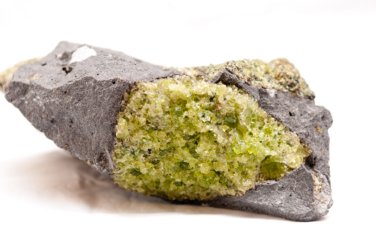1. Bastnaesite

The renewable energy transition requires a lot of electricity produced by movement and vice versa. Think about how the rotating blades of a wind turbine drive a generator that makes electricity. The key part in this movement-electricity switcheroo is a strong magnet. And if you have ever been out looking to buy a strong permanent magnet, then you know they don’t come much better than the neodymium magnet.
Neodymium is one of a group of chemical elements that we call rare earth elements. But where do these rare earth elements come from? The mineral bastnaesite! It was first discovered in the Bastnäs mine in Sweden, hence the name, but this mineral is mostly mined in China. If you've never heard of this mineral, you're certainly not alone, but bastnaesite is a name to remember. It’s hard to imagine an energy transition without this mineral.
Image by Rob Lavinsky, iRocks.com
2. Jadarite

Electric vehicles massively reduce the amount of carbon dioxide emitted by our transport, but they require light and powerful batteries that store enough electricity to drive hundreds of kilometres. We use lithium to make these batteries. Lithium comes from very salty brines in salt lakes high in the South American Andes. But in 2005, geologists discovered the mineral jadarite in vast quantities in rocks deep under the Jadar Valley in Serbia. It contains lithium and other elements. There should be enough jadarite in Serbia to make batteries for at least a hundred million electric vehicles.
The chemical makeup of this mineral is sodium-lithium-boron silicate hydroxide. This matches the chemical composition of the fictional material kryptonite almost perfectly (it doesn’t glow green though!). We don’t know whether jadarite would kill Superman, but its superpower may give a turbo boost to carbon-neutral driving.
Image by Dungodung - Own work
3. Chalcopyrite

As a society, we’re already using a lot of copper, and a world running on green electricity will need more, not less. Just think about all the cables to move electricity around. We get this shiny versatile metal from rocks containing less than one percent copper by weight. These rocks are mined in giant open-cast mines such as Escondida in Chile, the largest open-cast mine in the world.
The copper in these rocks is mostly contained in the mineral chalcopyrite. This mineral is a close relative to pyrite, which we also know as ‘fool’s gold’. But this is no fool’s material! Besides copper, chalcopyrite from some places contains small amounts of the chemical elements indium, gallium and germanium. That’s great news for the energy transition too, because those are high-tech elements needed for the next-generation solar panels, for example. This way the copper mineral chalcopyrite can help secure the supply of these critical raw materials for the energy transition.
Image by Rob Lavinsky, iRocks.com
4. Cobaltite

Medieval German miners digging for silver ore sometimes found ores that couldn’t be smelted properly, or that gave off foul vapours. They thought these ores were ‘bewitched’ by a mischievous mythical goblin-like creature named a kobold. Later, when the bewitched nature of the ore was found to be a new chemical element, it was named cobalt. Cobalt is a crucial element in the cathode of lithium batteries - essential for electric vehicles as well as our mobile phones and laptops.
But cobalt is one of the most problematic of all raw materials because more than half of the world’s supply comes from Central Africa, where its extraction is sometimes linked to child labour and human rights violations by local warlords who benefit from the mines. While many battery manufacturers aim to replace cobalt in their batteries, this has proved to be very challenging and there is currently little prospect of a cobalt-free battery. So, whether we like it or not, cobaltite, (hopefully certified and responsibly sourced), will likely be a mineral at the heart of the energy transition.
Image by User Tor Svensson
5. Olivine

Besides minerals that help us create a world without new carbon emissions, we also need to reduce the amount of the greenhouse gas carbon dioxide in the atmosphere back to safer levels. Olivine could come to the rescue. Olivine and carbon dioxide like to react with each other and turn into a new mineral - a magnesium carbonate named dolomite.
One ton of olivine reacts with 600 kg of CO2, making 1200 kg of carbonate and 400 kg of silica, a raw material for the cement industry and solar panels. While the large-scale applications of olivine to remove carbon dioxide from the atmosphere are probably a fairly long way off, promising experiments are already being done to build reactors in which this reaction can be run efficiently.
About the author
Arjan Dijkstra is an assistant professor in Earth Materials at the Faculty of Geoinformation Science and Earth Observation. His research focuses on the minerals that provide the critical raw materials for the Energy transition.
This is an edited version of an article on our premier online platform for high-quality geospatial content and cutting-edge education: Geoversity. Want to learn more about these minerals, read the full article on Geoversity.




